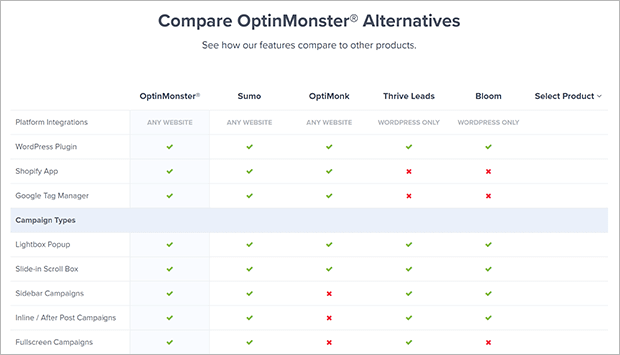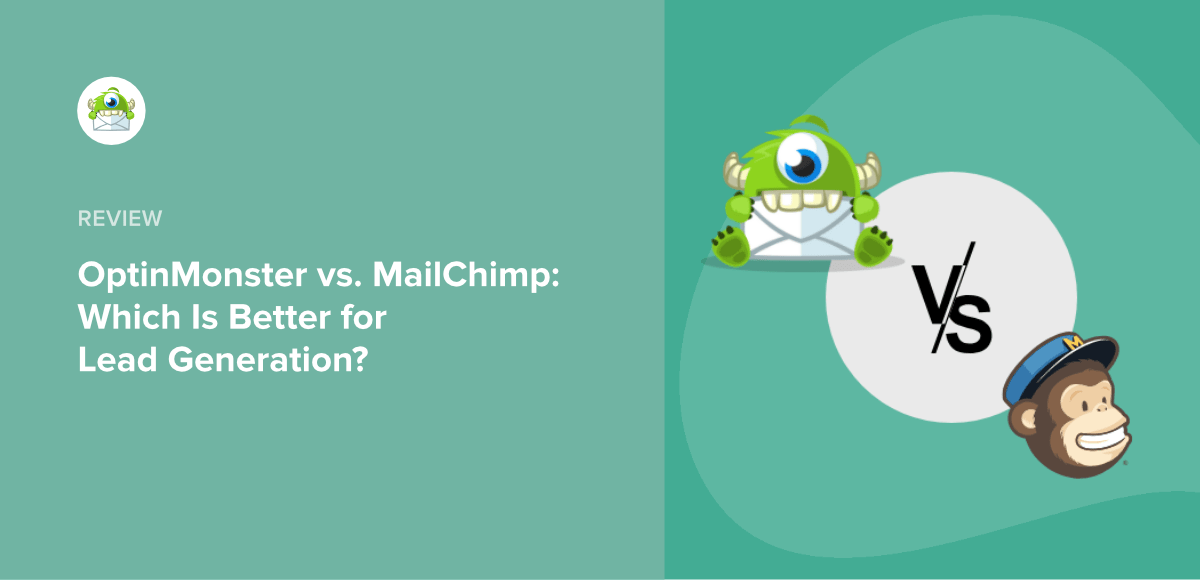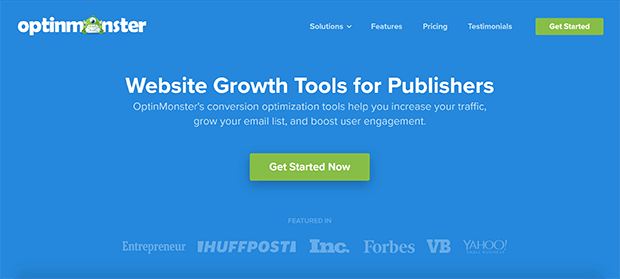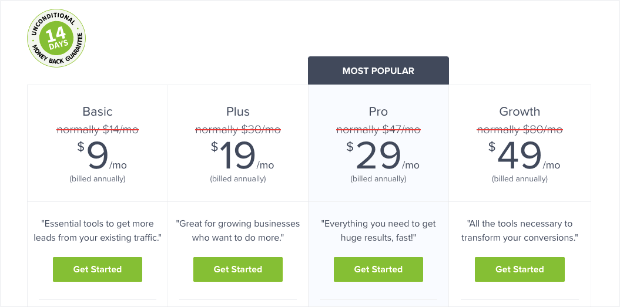Do you need ideas for your bottom of the funnel content?
Bottom of the funnel, or BOFU, content is essential if you actually want to make any sales. Fortunately, it’s not hard to produce. In fact, you may already have some bottom of the funnel marketing content that you can optimize.
In this article, we’ll discuss the different types of BOFU content and how to create it. Here’s a table of contents to help you find your way around.
- What is Bottom of the Funnel Content?
- How to Create Bottom of the Funnel Content
- 8 Types of Bottom Funnel Content
- Best Practices for Creating Bottom of the Funnel Content
- Conclusion: Start Creating Bottom of the Funnel Content Today!
Let’s take a look!
What is Bottom of the Funnel Content?
Bottom of the funnel content is meant to persuade a potential customer to make a purchase. BOFU content is often the last piece of content the customer sees before buying.
But your BOFU content can’t be a pure sales pitch. It still has to add value in some way. That might be removing final objections, making the purchasing process easier, or educating the customer.
The “funnel” in BOFU refers to the sales and marketing funnel that many businesses use. The shape of the funnel represents how many customers are at each stage. There are more potential buyers at the top of the funnel than at the bottom. As customers move through the funnel, they gradually build trust, awareness, and readiness to purchase.
Let’s compare bottom of the funnel content to content from other funnel stages:
- Top of the funnel content (TOFU) should build awareness of the problem
- Middle of the funnel content (MOFU) should build awareness of the solution
- Bottom of the funnel content (BOFU) should build awareness of the product
For example, if a company sells hair coloring products, here’s what their funnel content might look like:
- Top of funnel: 5 Reasons Your Hair’s Going Gray
- Middle of funnel: 3 Different Types of Hair Dye Processes
- Bottom of funnel: Hair Dye Brand A vs. Hair Dye Brand B
Visitors at the top of the funnel have just begun their research. Those at the bottom of the sales funnel are ready to make a decision.
How to Create Bottom of the Funnel Content
In order to create BOFU content, you must understand the buyer’s journey in great detail. What problem are they trying to solve? Where do they look for solutions? How do they make a decision?
To figure out your content ideas and messaging, we suggest conducting customer research. Speak to your past and current customers to understand their thought process and pain points. It’s also a good idea to ask customers who considered buying but didn’t. This is also a good way to try and recover some of those lost customers.
Here are some questions you can ask as you shape your marketing strategy:
- What problem were you trying to solve?
- What else did you try?
- How well did the other solutions work?
- What would you have liked to be different about the other solutions?
- For existing customers: What tipped you over into buying our product or service?
- For visitors who didn’t end up buying: What kept you from buying our product or service?
With this in-depth customer data, you’ll be able to produce the right content to persuade qualified leads to take the next step.
In the next section, we’ll go over specific tips for different types of content for the bottom of the funnel.
8 Types of Bottom Funnel Content
Case Studies
A case study is a detailed customer story about how they used your product or service to reach their goals. Case studies can also be used in the middle of the funnel, but because of their length tend to be most effective near the final stage of the funnel.
Case studies are more than simple success stories. They should also include an honest look at the problem the customer was facing before they encountered your company. People love to hear stories, especially if they can relate to the “main character.”
When writing case studies, make the customer the hero. Your brand is the sidekick or wise mentor who helped them find their way.
- Find a customer to feature who fits one of your buyer personas.
- Gather any data you have about this customer’s results.
- Interview the customer about their experience. You can use the customer research questions we mentioned in the previous section.
- Write up the case study. Make sure to include the challenge, solution, and results.
- Include a compelling headline that emphasizes the customer profile and a specific result they achieved.
Here are some examples from our case study library:
- How Nick Gray Increased Conversions by up to 1000% With Smart Opt-in Popups
- How PodBike Gets 18.22% More Email Subscribers with GeoTargeting
- How Human Food Bar Gets 1800+ Signups Per Month With OptinMonster
Reviews and Testimonials
A review is an opinion about a product or service, which may be given directly to the company or to a third-party website. A testimonial is a personal recommendation. Both can appeal to customers at all stages of the buyer journey.
Reviews and testimonials are a powerful form of social proof. They signal to potential customers, “Hey, other people are buying this!” We tend to look toward other people’s actions as an indicator of what the best choice is.
Think about when you look for something on Amazon. You probably look to see how many reviews the product has, and whether the overall rating is high or low. Everyone else is doing the same thing. Ratings and reviews can even show up on search engines, so they can be a form of TOFU content as well.
Include reviews and testimonials on your landing pages, product pages, blog posts, and throughout your website. If you find a particularly compelling review or testimonial, consider reaching out to the customer for a more detailed case study.
How to Ask for Testimonials, Reviews, and Ratings:
- Reach out at the right time. This may not be immediately after purchase but after they’ve had time to see results.
- Deliver value before you ask. If someone brings up an issue, resolve it first before requesting a testimonial or review.
- Offer an incentive for customer feedback.
- Ask the right questions so it’s easy for the customer to answer.
- Reach out on different channels, such as email, social media, on-page popups, and more.
- For software products, publish your brand on external review sites like G2, Product Hunt, Capterra. This can help bring in organic traffic.
Alternatives
The alternatives format is very popular and can attract lots of SEO traffic.
People who are considering a specific product often look up terms like, “OptiMonk alternatives” or “Elementor alternatives.” They want to make sure they aren’t missing out on a better solution.
These alternatives pages are a great way to show off your special superpowers. That doesn’t mean you need to insult your competitors. Simply emphasize what your brand does better than others.
How to Write an Alternatives Page:
- Choose a popular competitor. You can use search traffic metrics to guide this decision.
- Identify the features, use cases, and results that this product lacks, but that your product delivers.
- Write a review for the competitor, emphasizing what your product offers that they don’t.
- Repeat the process for similar products. Be sure to consider indirect competitors as well as direct competitors.
- Position your product as the best alternative for your target market, and include a call to action (CTA) to try it out.
Competitor Comparison
A competitor comparison is like a targeted version of the alternatives page. Instead of showcasing a variety of options, you’re taking a closer look at one specific competitor.
Competitor comparisons meet a similar search intent as the alternatives page. People who are searching for terms like “OptinMonster vs. Mailchimp” or “OptinMonster vs Bloom” are likely to be considering both options. Once they decide which one is better, they’re probably ready to make a purchase.
Your goal with a competitor comparison is to communicate your unique value proposition (UVP). In other words, what makes your product different from everyone else?
Once your reader understands your UVP, they can decide if your product is exactly what they’re looking for.
How to Write a Competitor Comparison:
- Pick a popular competitor. This can be a direct or indirect competitor.
- Identify your unique value proposition compared to this competitor.
- Choose the features, performance metrics, or use cases that you want to compare. Ideally, choose the ones your ideal customer cares about most.
- Review the competitor product in comparison to yours. Be fair and honest to maintain your credibility.
- If you can, create a comparison table or infographic that’s easy to scan. Save the details for the body of the page.
- Write a conclusion that points to your product as the winner.
Use Cases
Your potential customers probably don’t know all the features of your product, and they honestly may not care that much. What they care about is solving the problem they have. This is where use case pages can help.
A use case is an explanation of how your product features can help a specific type of user. For example, we have different pages about:
- OptinMonster for eCommerce
- How to Use OptinMonster to Reduce Cart Abandonment
- OptinMonster for Agencies
Additionally, on most of our feature pages, we discuss specific use cases for each feature. You can write use cases based on needs, industry, customer type, and other variables.
Use cases help customers understand how all the different features can benefit them. They do this by creating a mental picture of what using the product might actually look like for that customer.
How to Write a Use Case:
- Choose one of your ideal customer profiles to focus on.
- Identify what benefits that customer needs the most and why.
- Select the product features that provide those benefits.
- Explain how each feature delivers the benefits your customer needs.
- Show how your product can help the customer.
Webinars
Webinars are an excellent lead generation strategy at the bottom of the funnel. You can use webinars to educate your target audience and invite them to become your ideal customer.
There’s nothing better than seeing a product in action. Physical products can be shown off from different angles and in different situations. Digital products can be demonstrated live, or pre-recorded based on the most common questions and scenarios.
Webinars offer the chance to interact with your sales team in a more engaging way than email or even live chat. This can build a stronger customer relationship before and after the sale.
How to Sell Anything With Webinars:
- Identify the solution you want to help customers with on the webinar. They’re not signing up for a sales pitch. They want to learn something and solve a problem.
- Focus on a single topic, not everything that your product or service could possibly do.
- Set a date and promote the webinar on your email list, sites like LinkedIn, and of course, on your own website.
- Set aside time for questions at the end or throughout the webinar. This is where the high-value interactions take place.
- Optionally, include special offers at the end of the webinar to thank participants for attending and motivate them to purchase.
Check out our free webinar about growing your email list fast!
Product Demo Videos
In addition to live webinars, consider making a video tutorial or demonstration. Customers often use YouTube as a search engine now, and video content often converts very well.
A customer who’s searching for “OptinMonster demo” or “SeedProd overview” already knows about your product and wants to see it in action before making a purchase decision. These high-intent searches are an excellent opportunity to show off your product’s features. You can demonstrate physical goods, SaaS products, or other digital downloads.
How to Make a Product Demo Video:
- Pick a process or feature to demonstrate. Search term traffic can help you identify popular terms that customers are interested in.
- Use a camera or screen-recording software to record yourself demonstrating the product. Make sure to mention the benefits as well as the features.
Pricing Page
Don’t forget the pricing page, which is one of the most viewed pages on any website. Don’t waste the opportunity to convert high-intent customers!
The pricing page is often the very last page a prospect sees before deciding whether to buy or not. These customers don’t just want to know the price. What they really want to know is, “What do I get for this price?”
The best pricing pages show how each plan can suit different types of customers, different budget levels, or different use cases.
A pricing table can lay all this information out in a way that’s easy to understand.
How to Create a Pricing Page:
- Put the prices in a high-visibility spot, above the fold. Users who can’t find this information quickly will leave instead of hunting for it.
- Show the best option for different kinds of customers, such as startups, enterprise, and other groups.
- Highlight the most popular option to draw attention to it.
- Include a clear call to action.
- Remind the user of the benefits they can gain.
- Use social proof like testimonials, user numbers, and reviews.
You can see we’ve done all these things on OptinMonster’s pricing page.
Best Practices for Creating Bottom of the Funnel Content
Regardless of the bottom funnel content types you decide to create, we recommend these best practices for your content strategy.
Focus on One Buyer Persona
At this stage in the buying process, the buyer is very serious about making a decision. Take them seriously in return by tailoring your content to their specific needs and concerns.
Don’t try to write a white paper or case study that every possible customer will find interesting. That’s just not possible, and you’ll end up with boring, generic content that no one cares about.
Instead, focus each piece of BOFU content on one specific buyer persona. You may want to narrow even further to 1 or 2 specific use cases for each persona.
Match the Intent of the Buyer
When creating your BOFU content, make sure it aligns with the specific questions your potential customers are asking.
Someone looking for “[product] alternatives” may have some hesitations about the original product. Maybe it’s more expensive than they really wanted to pay, or it’s missing a feature they really need. Address those hesitations in your content.
As another example, someone searching for “[product] pricing” wants to know the price and the value of the product. Make that information clear and easy to find.
Don’t Stress About Search or Traffic Volume
Bottom of the funnel content may not have particularly high amounts of search traffic. That doesn’t mean you should ignore those keywords or searches.
What matters most is intent. BOFU search terms are very high-intent, which means the reader wants an answer and is also ready to make a decision.
Keyword research and traffic patterns can guide your BOFU marketing strategy, but it’s not the only factor to consider. More important is the actual buyer journey your customers are on.
Include a Clear and Consistent CTA
The worst thing to do would be to attract so many high-intent visitors, then forget to invite them to take the next step! Your call to action at the bottom of the funnel will likely be a purchase, or perhaps booking a call with you. Make sure to include at least one CTA on each piece of BOFU content. If you include multiple CTAs, make sure they are consistent with each other. Don’t ask them to download a lead magnet in one place and then follow you on social media somewhere else.
Conclusion: Start Creating Bottom of the Funnel Content Today!
We hope this article helps you understand the importance of bottom funnel content and how to create your own.
Next, check out more specifics about:
- How to Build a Content Marketing Funnel
- How to Create an Email Marketing Funnel
- How to Create an Online Challenge Funnel
Don’t forget to promote your bottom of the funnel content on your website using OptinMonster!




















Add a Comment